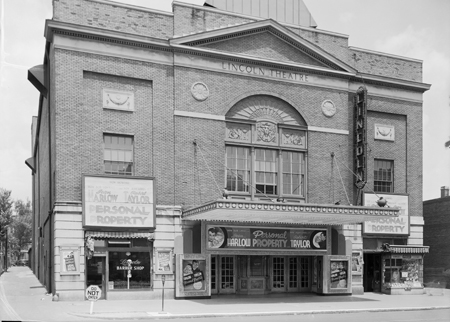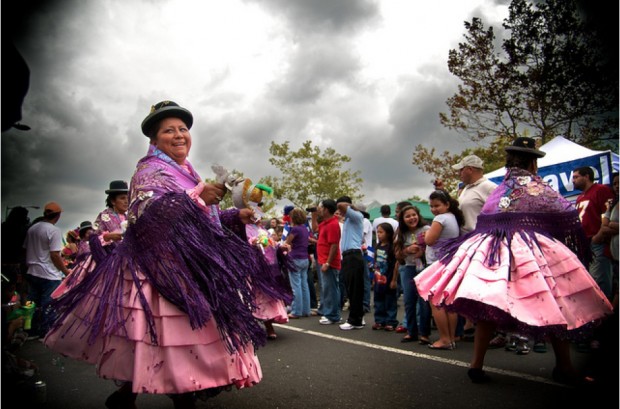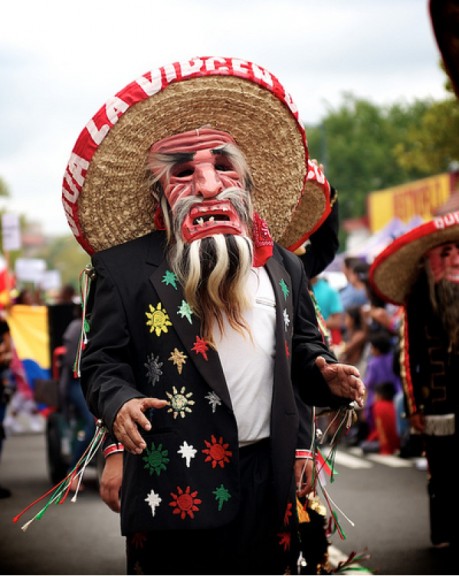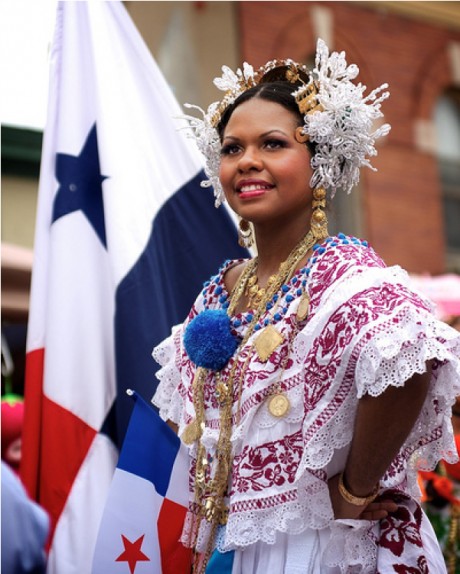RECENT POSTS
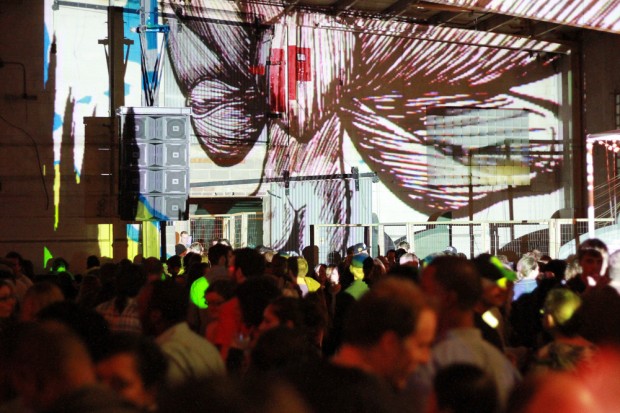
Nahal Tavangar / @NahalTav
About 1,200 people attended the fourth annual Cherry Blast party in Anacostia.
Trapeze artists hovered above a crowd. A band played electronic music as green lasers flashed through the room. Nearby, people created silk-screened T-shirts, a video installation played against the wall and the crowd tossed a large, clear plastic bubble filled with pink balloons in the air.
The annual Cherry Blast event on Saturday night was in many ways a creative, warehouse party. It pulled together all sorts of artistic and musical spectacles that attracted a racially diverse crowd of 1,200 willing to pay $10 a ticket to enter.
But this party didn’t happen in Northwest or near gentrifying H Street NE. Cherry Blast, produced by The Pink Line Project, took place in a vacant police evidence warehouse in Anacostia, and drew attendees largely from other parts of town, many of whom were young and white.
Anacostia has a rich history, but in recent years the neighborhood has developed a reputation as dangerous and poor, a perception that local activists have been battling. It’s a mostly black neighborhood that doesn’t typically attract many white people.
Cherry Blast comes on the heels of Lumen8Anacostia, a weekend of art events and pop-ups held throughout the neighborhood. These events have given people, who normally don’t trek east of the Anacostia River, a reason to visit the neighborhood. But in doing so, they’ve raised questions about race and class.
Continue reading →
Want to end racism? Why not start with putting it on a T-shirt.
Until 8 p.m. today, a pop-up booth will be in Farrguat Square where people can create T-shirts with customized messages. It’s part of USA Network’s Characters Unite campaign to bring awareness to hate and discrimination.
Passersby can stamp T-shirts that read “I won’t stand for…” with a number of words, including discrimination, intolerance, homophobia, racism, sexism and hate. Some individuals, including D.C. Mayor Vincent Gray, told DCentric about what they chose to stand against. Is there anything you won’t stand for? Why?
Prev
Next
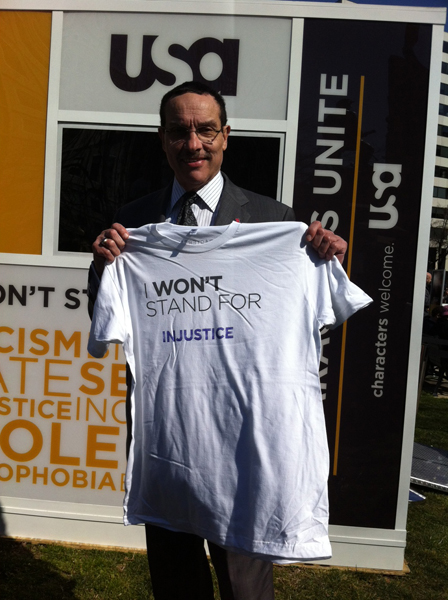
Elahe Izadi / DCentric permalink
Mayor Vincent Gray linked his T-shirt message to the fight for D.C. statehood. The District doesn’t have a voting member in Congress. “We live with injustice every day in the District,” Mayor Gray said. “We live in a city where we can’t even approve our own budget with money we raised on our own. That, to me, is an injustice.”
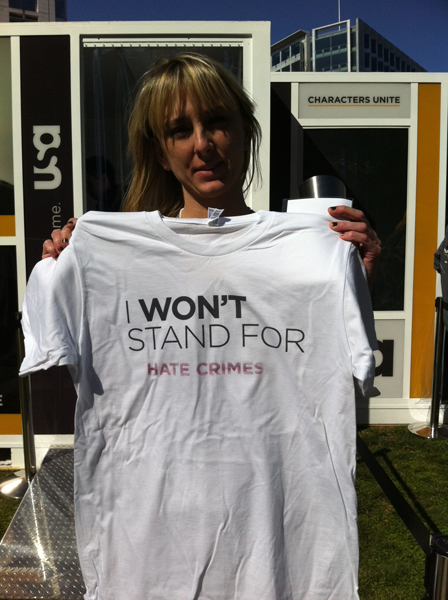
Elahe Izadi / DCentric permalink
Rebecca McClay, 34 of D.C. said she wouldn’t stand for hate crimes against any variety. “It’s something that’s really appalling,” she said. “It seems to be in the news a lot lately and it seems to be very difficult to stop.”
Elahe Izadi / DCentric permalink
Charles King, 42, lives in Virginia. He said discrimination stood out to him. “I have dealt with it myself, my dad has, going back generations,” he said. “In this millennium, something like that shouldn’t exist.”
Elahe Izadi / DCentric permalink
Cary Hatch, 55, owns an advertising agency near Farragut Square and brought her employees to the booth. “Hate in any form really doesn’t fit in today’s society,” she said. “Whether I see discrimination or just people being marginalized, it’s all a form of hate.”
Elahe Izadi / DCentric permalink
Kennethia Simmons said she wouldn’t stand for violence. “People are getting killed every day over something dumb,” she said. The 20-year-old D.C. resident said her brother was killed last year.
Elahe Izadi / DCentric permalink
Tanya Moore, 36 of Oklahoma, works in a soup kitchen and food pantry. She chose injustice because “it fits pretty much everything we see and deal with on a daily basis.”
Elahe Izadi / DCentric permalink
Erica Hunter, 33 of Maryland said, “I don’t deal well with individuals who can’t tolerate others on any level.”
Elahe Izadi / DCentric permalink
Lanie Liem, 22 and an intern temporarily living in D.C, is originally from California, says she’s an advocate for LGBT, or lesbian, gay, bisexual and transgender rights. “In California, we had the whole vote on Proposition 8,” she said, referring to a referendum that would outlaw gay marriage. “It’s stressful that we have a vote on our rights.”
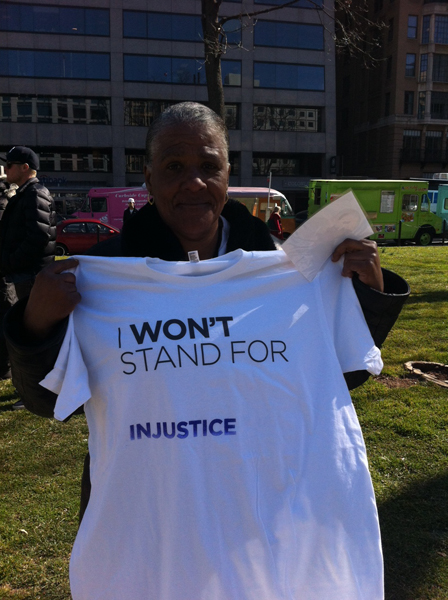
Elahe Izadi / DCentric permalink
Althea Edwards, 50 of D.C., said she wouldn’t stand for injustice, particularly as it relates to homelessness and healthcare. “There’s a lot of injustice in America and if we don’t pull together we’re not going to get out of this mess,” she said.
From Northwest to Southeast, D.C.’s public murals help tell the story of black history. Take a look at our gallery below, showcasing some of these public artworks.
Notable figures depicted in the murals include: Carter G. Woodson, considered “the father of black history;” activist and leader Malcolm X; abolitionist and writer Frederick Douglass; and poet Langston Hughes.
Some of the murals are funded by the District government, while others are privately-commissioned. There are also a few that are quite new, while others will soon disappear due to development. The gallery presents a snapshot of D.C. murals relating to black history, so feel free to post photos of other such murals in the comments section.
Prev
Next
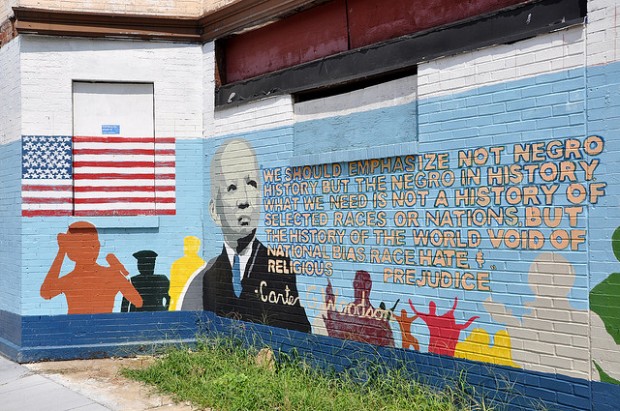
Kevin Harber / Flickr permalink
This mural on 7th Street NW in Shaw depicts historian Carter G. Woodson, considered the "father of black history." Woodson lived in D.C.
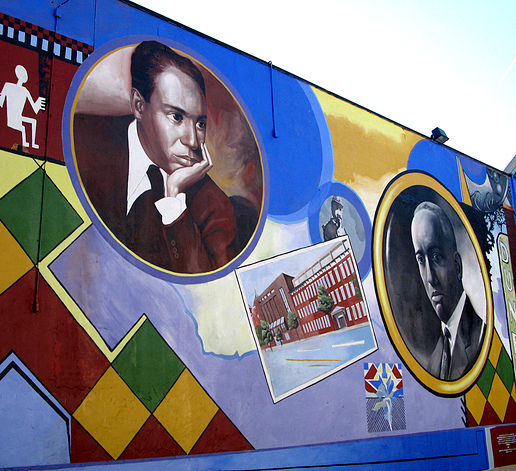
art around / Flickr permalink
Poet Langston Hughes and historian Carter G. Woodson, both once Shaw residents, are depicted in the Shaw Community Mural on 9th Street NW. The Shiloh Baptist Church is also shown in the mural, a black church that played an important role in Shaw's community life.
Courtesy of Aniekan Udofia permalink
Frederick Douglass is the centerpiece of this mural on Bread for the City's building on Good Hope Road SE. Douglass lived in a home nearby.
Michael Loadenthal / flickr.com/photos/michaelimage permalink
Malcolm X is included in a mural on the building housed by Sankofa Cafe and Bookstore on Georgia Ave NW. The image comes from a famous poster that shows Malcolm X wiedling a rifle and looking outside of a window, underneath the words "By any means necessary."
Daniel Lobo / Flickr permalink
This relatively new mural off of U Street NW includes imagery evoking the 1963 March on Washington, which was originally called "March on Washington for Jobs and Freedom."
art around / Flickr permalink
Duke Ellington is one of Washington's native sons. This mural on U Street NW was originally near the U Street Metro Station but was dismantled and moved a few blocks down to the True Reformer Building.
Courtesy of Aniekan Udofia permalink
This Duke Ellington mural was just completed in late 2011, and was painted on a building on Ward Place NW near where the jazz legend was born.
Daniel Lobo / Flickr permalink
This mural off of New York Avenue NE pays homage to some of D.C.'s great music legends, including Marvin Gaye.
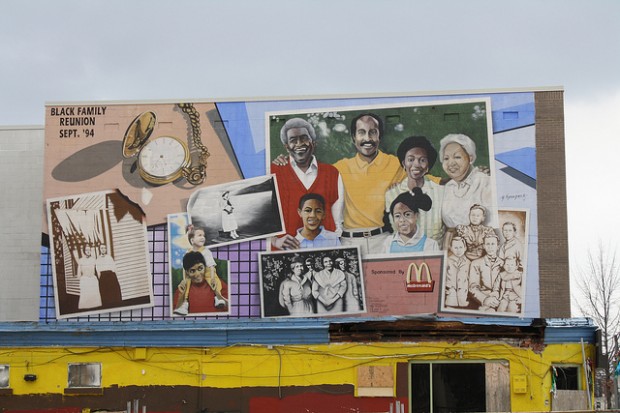
Elvert Barnes / Flickr permalink
The Black Family Reunion mural shows a collage of an anonymous family through the years. Originally commissioned by the National Black McDonald's Operators Association, the 18-year-old mural on 14th Street NW will soon be replaced by development.
Thousands attended D.C.’s Chinese New Year parade on Sunday to celebrate the start of the year of the dragon. Organizers aimed to hold a bigger event this year, despite downtown seeing its Chinese American population decline.
“We know there have been a lot of changes in our city in recent years,” Mayor Vincent Gray told the crowd, reports Chinese Radio International, “but what hasn’t changed and will hopefully not change is the presence of Chinatown as an important cultural center here in the District of Columbia.”
Check out these Flickr photos of the parade by local photographers Glyn Lowe, Victoria Pickering and Russell Brammer:
Prev
Next

Glyn Lowe Photos / Flickr permalink
D.C.'s Chinese New Year Parade took place on Sunday, one week after the start of the new year.
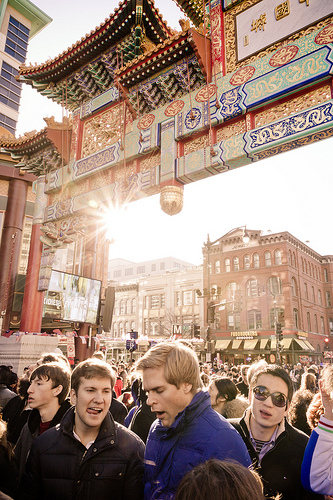
Russell Brammer / Flickr permalink
Thousands attended the annual parade in D.C.'s Chinatown.
Victoria Pickering / Flickr permalink
Members of Anacostia High School's marching band participated in the parade.
Russell Brammer / Flickr permalink
Flags wave near Chinatown's "Friendship Archway" on 7th and H streets NW.
Victoria Pickering / Flickr permalink
The parade celebrated the start of the year of the dragon.
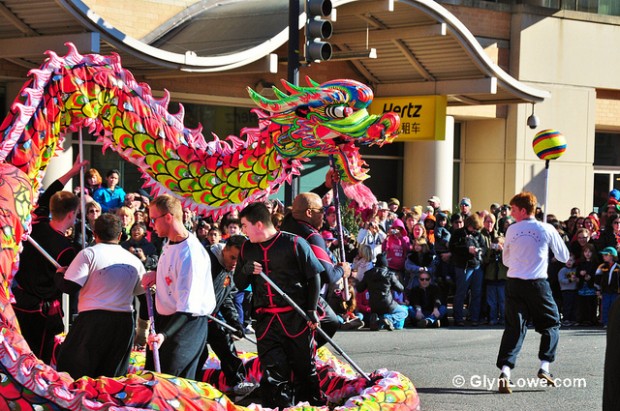
Glyn Lowe Photos / Flickr permalink
The parade marched through Chinatown, one of D.C.'s busiest commercial districts.
The D.C. riots that erupted in the wake of the 1968 Martin Luther King, Jr. assassination resulted in more than 1,000 burned down buildings, dramatically changing the District’s landscape. Such damage altered the course of the city’s development, and the riots are still brought up in current discussions over gentrification and revitalization.
But exactly how did the city look during the four days of rioting? Yale University has released a collection of rare negatives documenting the riots and the government response. They were taken by part-time Associated Press photographer Alexander Lmanian, and the images he captured show soldiers mobilizing in D.C. streets, people looting and damaged storefronts. See our gallery below:
Prev
Next
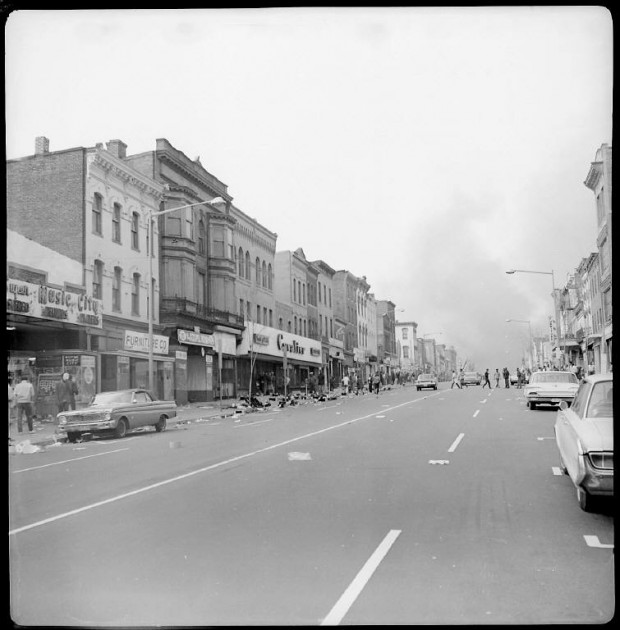
Alexander Lmanian / General Collection, Beinecke Rare Book and Manuscript Library, Yale University permalink
Rioters, soldiers, and damaged buildings during the riots.
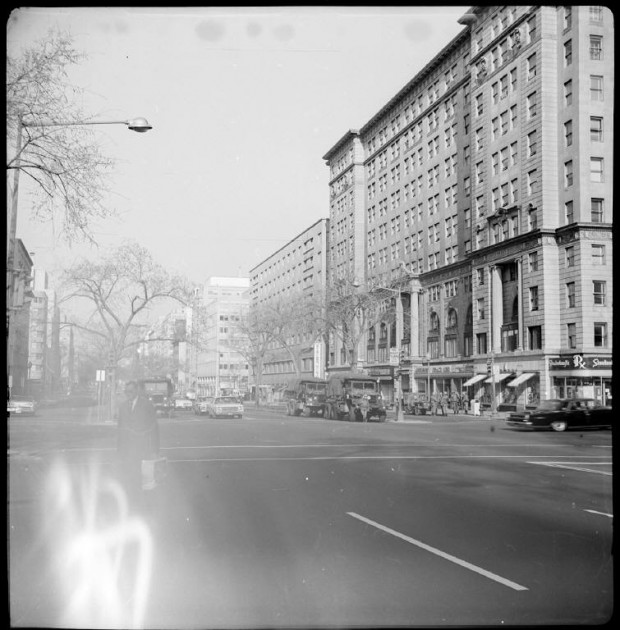
Alexander Lmanian / General Collection, Beinecke Rare Book and Manuscript Library, Yale University permalink
Cityscapes during the riots in the vicinity of H Street NE between 7th Street NE and 13th Street NE.
Alexander Lmanian / General Collection, Beinecke Rare Book and Manuscript Library, Yale University permalink
Rioters, soldiers, and damaged buildings during the riots.
Alexander Lmanian / General Collection, Beinecke Rare Book and Manuscript Library, Yale University permalink
United States Army helicopter used to spot rioters
Alexander Lmanian / General Collection, Beinecke Rare Book and Manuscript Library, Yale University permalink
Rioters, soldiers, and damaged buildings during the riots.
Alexander Lmanian / General Collection, Beinecke Rare Book and Manuscript Library, Yale University permalink
Damage in the aftermath of the riots.
Alexander Lmanian / General Collection, Beinecke Rare Book and Manuscript Library, Yale University permalink
Rioters, soldiers, and damaged buildings during the riots.
Alexander Lmanian / General Collection, Beinecke Rare Book and Manuscript Library, Yale University permalink
Rioters, soldiers, and damaged buildings during the riots.
Alexander Lmanian / General Collection, Beinecke Rare Book and Manuscript Library, Yale University permalink
Police helicopters and emergency troops in the Capitol District during the riots, 11:00-11:30 a.m.
Alexander Lmanian / General Collection, Beinecke Rare Book and Manuscript Library, Yale University permalink
Damage in the aftermath of the riots
Alexander Lmanian / General Collection, Beinecke Rare Book and Manuscript Library, Yale University. permalink
Luther Place Memorial Church, and cityscapes that show the aftermath of the 1968 riots.
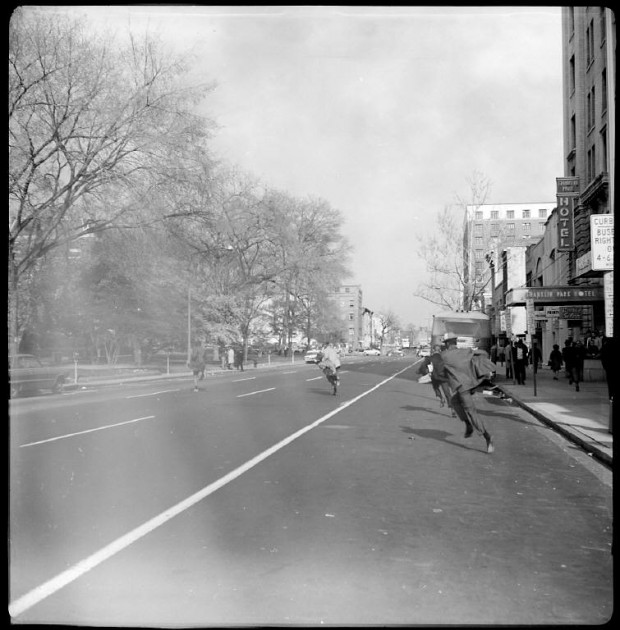
Alexander Lmanian / General Collection, Beinecke Rare Book and Manuscript Library, Yale University permalink
Rioters, soldiers, and damaged buildings during the riots.
Prev
Next
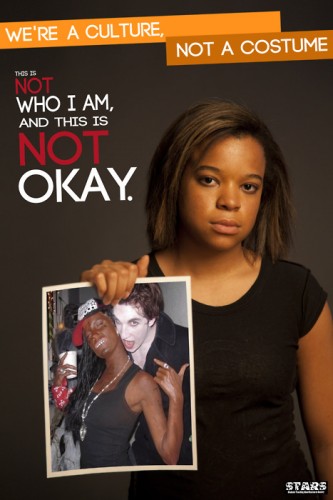
Ohio University's Students Teaching About Racism in Society has released these posters as part of a Halloween awareness campaign.
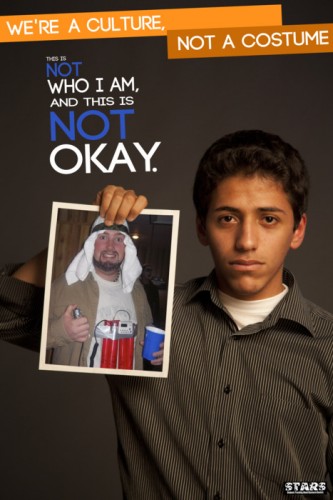
Ohio University's Students Teaching About Racism in Society has released these posters as part of a Halloween awareness campaign.
Ohio University's Students Teaching About Racism in Society has released these posters as part of a Halloween awareness campaign.
Ohio University's Students Teaching About Racism in Society has released these posters as part of a Halloween awareness campaign.
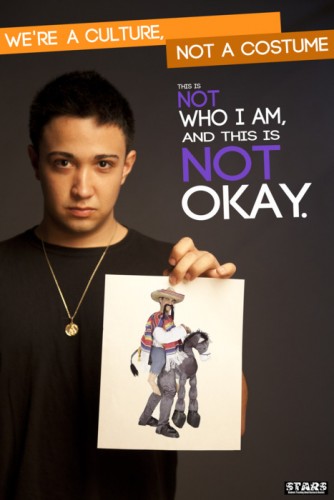
Ohio University's Students Teaching About Racism in Society has released these posters as part of a Halloween awareness campaign.
Is it racist to dress up as a Mexican for Halloween? Yes, according to a group of Ohio University students who launched the “We’re a culture, not a costume” campaign now gaining national attention.
Sarah Williams, president of the Ohio student group STARS, said on CNN: “During Halloween, we see offensive costumes. We don’t like it, we don’t appreciate it… The best way to get rid of stereotypes and racism is to have a discussion and raise awareness, which is what we want to do with this campaign.”
Why is it problematic to dress up as a Mexican for Halloween? Jelani Cobb, African studies professor at Rutgers University, explains to CNN:
“To treat a character like Batman or Superman as a Halloween costume is one thing, but to treat an entire ethnicity as a costume is something else. It suggests that people conflate the actual broad diversity of a culture with caricatures and characters.
But not everyone agrees; negative comments flooded Melissa Sipin’s blog, which first reported about the campaign on Sunday before national media took note. Critics feel the campaign is a hyper-sensitive reaction to people who simply want to have fun on Halloween, a time to relax and check all the seriousness at the door. Sipin responds to such critics:
This poster campaign isn’t about being overly sensitive to costume choices, it’s about perpetuating prejudices and negative stereotypes through these choices. All we’re asking people is to stop perpetuating those prejudices and to realize that you’re crossing a line when you strap fake bombs to your chest to portray a Middle Eastern man or if you paint your face black.
What do you think of the question raised by the posters? Take our poll:
Continue reading →
By Mary-Alice Farina
The Lincoln Theatre is approaching its 90th anniversary as a cultural beacon of the U Street district. But impending closure threatens to break an important chain in D.C. history.
The theater opened in 1922 at 12th and U Streets, at the height of the racial ghettoization of D.C. Although the District outlawed Jim Crow laws in 1917, segregation became a reality in D.C. Racially restrictive housing covenants and Depression-era laws ended up restricting housing and services to non-whites in certain neighborhoods.
Prev
Next

Courtesy of Library of Congress Prints and Photographs Division permalink
Atermath of 1968 race riots.

Poster for Cab Calloway performance at the Lincoln Theatre's ballroom.
In the face of this, U Street evolved into Black Broadway, an inimitable nexus of businesses, civil institutions, entertainment venues and homes. The area first experienced a boom after the Civil War, as thousands of new residents moved from the south. Between 1900 and 1948, U Street proved a vital epicenter for those suffering under the legacy of slavery.
Continue reading →
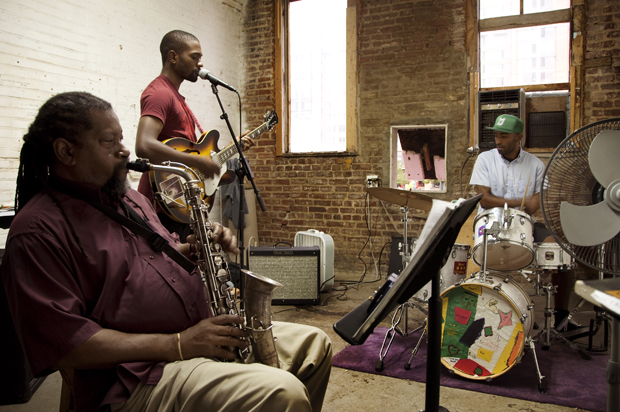
Courtesy of Bora Chung
Aaron Martin (left), Brandon Moses (middle) and Michael Andrew Harris (right) practice in Gold Leaf Studios.
Brandon Moses and Michael Andrew Harris, members of the band Laughing Man, met up at their studio space in a worn warehouse on a recent Thursday evening. Moses strummed his guitar and sang into the mic. Aaron Martin, who shares the studio with the band, joined in on his saxophone for an impromptu jam session.
Seemingly neglected, the vacant warehouse has been repurposed for just this sort of activity — for artists to create without concern of disturbing neighbors. Harris rapidly hit his snare drum without constraint. The music went through open window and spilled onto the Mt. Vernon street below.
But through that window, you could see the new high rises across the street, a sign of D.C.’s healthy real estate market. And soon, the warehouse — home to Gold Leaf Studios — will be replaced with a $57 million, 11-story mixed-used complex. About 30 artists who work out of 11 Gold Leaf studios will have to vacate by January 2012.
“Obviously they’re going to make a lot more money,” Harris, 31, said. “We’re just artists paying a couple of hundred dollars for the space.”
Continue reading →
So much happened over the weekend in D.C. that you may have missed out on Sunday’s Fiesta DC. Luckily, local photographer Pablo Benavente was on the scene and captured these great images of the parade (see more here).
The annual event showcases cultures from all around Latin America. It took place in Mount Pleasant, one of the centers of D.C.’s Latino community. The District’s Latino population is growing, mostly due to an increased presence of Central Americans.
Pablo Benavente / Flickr permalink
Prev
Next
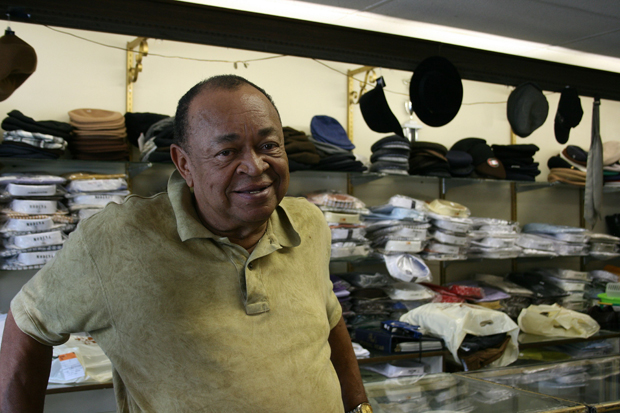
Elahe Izadi / DCentric permalink
George Butler, 73, will be closing his men's clothing store after 44 years on H Street NE.

Elahe Izadi / DCentric permalink
George's Place Ltd. will close in a few months. No word yet on what will take its place at 10th and H Streets, NE.
Elahe Izadi / DCentric permalink
An employee rings up a customer at the register.
Elahe Izadi / DCentric permalink
Butler says he has a particular eye for fashion and takes care to stock his store with items he knows customers will like.
Elahe Izadi / DCentric permalink
A sign on the front of George's Place reminds passersby how long it's been on the corridor.
Elahe Izadi / DCentric permalink
An employee sorts through items at George's Place. Owner George Butler says he's known for his selection of hats.
Elahe Izadi / DCentric permalink
George Butler speaks with longtime customers about his impending closure.
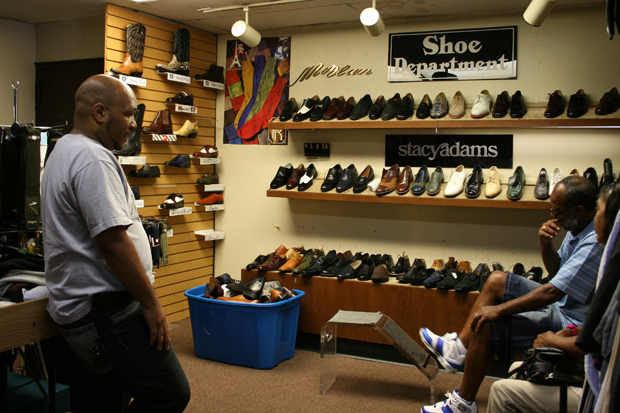
Elahe Izadi / DCentric permalink
A customer tries on shoes, hoping to take advantage of George's Place's going out of business sale.
George Butler is closing shop after nearly five decades. His men’s clothing store, George’s Place Ltd., is an H Street NE institution, one of the longest-running businesses on a corridor now synonymous with gentrification. But the recession, online competition and H Street streetcar construction led him to call it quits.
The 73-year-old managed clothing stores on the street in the 1950s before opening his store in 1968.
“I saw a future in H Street and my being in the neighborhood, I knew a lot of my customers,” he said while sitting in the back of his store on a recent afternoon. Hats and shoes lined the walls, along with 50 percent off signs.
Through it all, he’s had a front row seat to all the ups and downs of the corridor: from the heyday when it was “it was like Connecticut Avenue, like downtown,” to the 1968 riots. “I’m a vet, and I saw things I never saw in the war,” he recalled of the riots. “The street was unreal. Fires were everywhere. It was just burning down.”
The riots marked the commercial decline of the street, beginning decades of empty storefronts. “People left and never came back,” Butler said.
Continue reading →



















